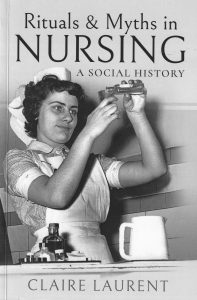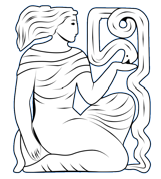| Sylvia Dunn, Riverside Museum, University of Chester | The UKAHN Bulletin |
| Volume 8 (1) 2020 | |
 Claire Laurent has written an interesting account of “Rituals and Myths in Nursing” and it really is a social history.
Claire Laurent has written an interesting account of “Rituals and Myths in Nursing” and it really is a social history.
Using anecdotes from her own, and friends, training days and also from older family members (she is fortunate to have nurses, doctors and midwives in her immediate family), the book reads like a personal memoir. It is interspersed with references to experiences and events from nursing history over the past 100 years, from the beginning of nurse registration through to the 1990’s.
Laurent also uses comments from participants of the RCN oral history project to complement her own research, to good effect. They give a very personal aspect to the book, adding to the interest of the reader, especially for interested members of the public.
Her experiences of training in a Teaching hospital run throughout the book. She trained at St Bartholomew’s Hospital, (Bart’s) London, and there were a number of rituals relating to uniform which went back many years. Her description of making up a nurse’s cap as a new probationer nurse is comical. How many prospective student nurses elsewhere, were expected to have a round shortbread biscuit tin with them, to assist in the making up of the nurse’s cap? Other teaching hospitals had equally bizarre uniform idiosyncrasies. However, these caps were worn with pride, and it seems for long periods before laundering. There are passages throughout the book relating to uniform from different hospitals which will cause consternation amongst younger readers.
The chapter headings draw the eye immediately; for example: ‘Nurses who Rustle’, ‘Egg white and Oxygen’, and ‘Bladder, Bowels and Bodily Functions’. Each chapter is themed, and in ‘Oxygen and Egg White’ for instance, it is difficult to believe that around 50 years ago, some practises had been performed for many years before that, so truly rituals based on myths. This is particularly true regarding pressure sores care.
The hierarchical nature of nursing, based on the military model, is explored particularly in the chapter ‘Handover and Hierarchy’, but is reflected throughout the book.
The author skilfully weaves her own opinions into the narrative with humour and sometimes exasperation. However, this does not detract from the flow of information in the book, which I (I trained 20 years before her) found a fascinating reflection of a time in nursing history that I had experienced personally.
The past should not be denigrated or forgotten, but viewed in the context of the knowledge and practice of the day. Change was afoot, and Laurent captures the developments ahead and convinces us that using a research-based approach to nurse training, really has brought nursing into a more enlightened and knowledgeable profession.
Laurent acknowledges the RCN oral history and the contributions from her own contacts, which are invaluable. There are some very sad anecdotes as well as genuinely “laugh out loud” instances. I for one, will be unable to look at a chocolate Brazil or a Malteser in the same way ever again. You need to read this book to find out why.
Whilst today’s University nursing students will be horrified at parts of this book, it is a worthy addition to a nurse’s library. It will be excellent ‘reminiscence therapy’ for retired nurses and the references and bibliography will enable interested readers to find additional information.
I do have one regret, the book would have been enhanced by more photographs. The illustrations are good but just not enough of them! However, it is a really easy and enjoyable read.
